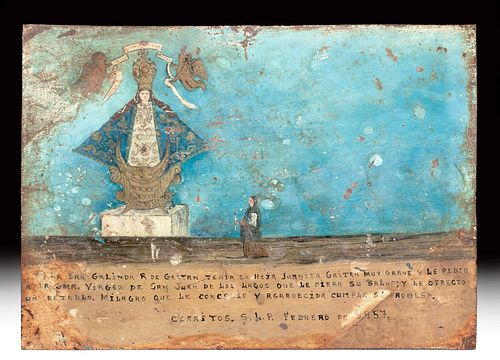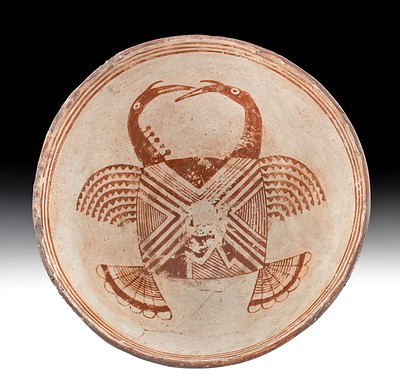Vintage Mexican Ex Voto - Mother & Child, 1954
Lot 146
About Seller
Artemis Gallery
686 S Taylor Ave, Ste 106
Louisville, CO 80027
United States
Selling antiquities, ancient and ethnographic art online since 1993, Artemis Gallery specializes in Classical Antiquities (Egyptian, Greek, Roman, Near Eastern), Asian, Pre-Columbian, African / Tribal / Oceanographic art. Our extensive inventory includes pottery, stone, metal, wood, glass and textil...Read more
Estimate:
$800 - $1,200
Absentee vs Live bid
Two ways to bid:
- Leave a max absentee bid and the platform will bid on your behalf up to your maximum bid during the live auction.
- Bid live during the auction and your bids will be submitted real-time to the auctioneer.
Bid Increments
| Price | Bid Increment |
|---|---|
| $0 | $25 |
| $300 | $50 |
| $1,000 | $100 |
| $2,000 | $250 |
| $5,000 | $500 |
| $10,000 | $1,000 |
| $20,000 | $2,500 |
| $50,000 | $5,000 |
| $100,000 | $10,000 |
| $200,000 | $20,000 |
About Auction
By Artemis Gallery
Apr 22, 2021
Set Reminder
2021-04-22 12:00:00
2021-04-22 12:00:00
America/New_York
Bidsquare
Bidsquare : Art & Artifacts of North America
https://www.bidsquare.com/auctions/artemis-gallery/art-artifacts-of-north-america-6851
Join us for a special auction featuring an important collection of Native American points and artifacts from Charlie Meyers, famed illustrator for Greg Perino. Artemis Gallery info@artemisgallery.com
Join us for a special auction featuring an important collection of Native American points and artifacts from Charlie Meyers, famed illustrator for Greg Perino. Artemis Gallery info@artemisgallery.com
- Lot Description
Latin America, Mexico, ca. 1954. A sweet ex-voto devotional painting, hand painted on heavy gauge tin. The composition presents a mother holding her child in one arm and a candle in the other which she holds up toward the vision of the Virgin flanked by angels who hold a banner that reads "Mater Inmaculada Orans" before her. Below is an inscription that roughly translates, "Senora Galinda R. was screaming when she found her daughter Juanita seriously ill and asked the Virgin of San Juan de los Lagos (of the Lakes) to cure her and offered this retablo to the Virgin. Miraculously, she conceded and fullfilled this request. Cerritos, SLP (San Luis Potosi) February 1954." Size: 9.125" W x 6.75" H (23.2 cm x 17.1 cm)
Ex-votos are narrative paintings created to ask for healing or blessing that are popular in Mexican visual culture. This tradition was inspired by the Greeks and was brought to the New World by the Spaniards. These votive paintings were hung in a church or placed adjacent to an image in order to celebrate and give thanks for the recovery of the donor or the donor's love one(s) from an illness or dangerous situation. In essence, ex-votos represent the spiritual or physical gains received by the donor. These paintings include hand painted passages that relate the details of the cure or the rescue. Typically, however, this commentary is replete with regional dialect and difficult to translate. Nevertheless, if one is familiar with the Spanish language, it is possible to get the gist of these anecdotal paintings, especially given the visual imagery.
Provenance: ex-Locati Gallery
All items legal to buy/sell under U.S. Statute covering cultural patrimony Code 2600, CHAPTER 14, and are guaranteed to be as described or your money back.
A Certificate of Authenticity will accompany all winning bids.
We ship worldwide and handle all shipping in-house for your convenience.
#162784Surface wear with stains and abraded areas commensurate with age. Imagery and inscription are still relatively legible. Usual waviness and bending to corners of the tin sheet.Condition
- Shipping Info
-
All shipping is handled in-house for your convenience. Your invoice from Artemis Gallery will include shipping calculation instructions. If in doubt, please inquire BEFORE bidding for estimated shipping costs for individual items.
-
- Buyer's Premium



 EUR
EUR CAD
CAD AUD
AUD GBP
GBP MXN
MXN HKD
HKD CNY
CNY MYR
MYR SEK
SEK SGD
SGD CHF
CHF THB
THB













